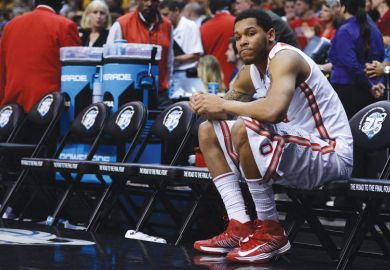A landmark revenue sharing agreement for athlete salaries could cause “enormous problems” for the pipeline of US college students competing at the Olympic Games, according to experts.
When it comes to the Olympics, the National Collegiate Athletics Association (NCAA) is a big player, regulating and organising university programmes across the US. Sportsmen and women who compete or have competed in its fixtures and conferences won more medals at the games in Tokyo than any country.
Two-thirds of the US squad in Paris – including 100m silver medallist Sha’Carri Richardson, double-gold medal swimmer Katie Ledecky and basketballer Steph Curry – came through the collegiate sports route, as did many athletes representing other countries.
For Great Britain and Northern Ireland, gold medal winner Hannah Scott rowed at Princeton University and 1,500m runner-up Josh Kerr ran track at the University of New Mexico.
“It’s the best place in the world to train,” according to Victoria Jackson, a sports historian and clinical associate professor of history at Arizona State University, where Léon Marchand, the French face of the Olympics, studied and swam.
“If you want to be the best in the world at what you do, the chances are the best way to get there is to come through American colleges – because [American] football has paid for that world-class [campus training] infrastructure.
“A lot of the signalling that athletes in other sports get is that they’re of a second class to football, but I think athletes really understand that football is subsidising their sport.”
This “massive money transfer” away from football towards other sports is set to be complicated by an upcoming revenue-sharing plan that would see schools directly pay their student-athletes.
While it will not become policy until 2025, and while there will be many “plot twists” before then, there are likely to be huge changes on the way, Professor Jackson said.
“Football-driven realignments in college conferences are presenting an enormous problem for an NCAA Olympic pipeline that has existed since the 1970s,” agreed Amy Bass, professor of sport studies at Manhattanville University.
“The cost of paying high-profile athletes, which I am not against, is going to take money out of the coffers of the sports that football and basketball somewhat underwrite.
“The cash flow from the big NCAA conferences is going to change dramatically with a new revenue-sharing model. We just don’t know if this means other sports will be cut, and which ones it will be if so.”
Many colleges have already been forced to cut sports programmes in recent years, with Olympic favourites such as gymnastics and tennis often bearing the brunt of financial pressures.
While many are blaming “greedy” football players for the “potential death or decline of Olympic development”, Professor Jackson said higher education should take the blame for long having made lots of money off these athletes.
“Higher ed tried to fight and preserve something that was exploitative and unsustainable for far too long, and it’s the institution that held the responsibility to fix it,” she said.
“It claims to be this world-leading, innovative, creative force, and it chose not to clean up its own house.”
La Quita Frederick, associate professor of practice in sports industry management at Georgetown University, said the revenue-sharing agreement has the potential to be both a “danger and a boost” to Olympic sports such as athletics.
It could lead to increased financial support for athletes, potentially leading to better performances at the Olympics, but it could also widen existing disparities between sports, she said.
“The impact will largely depend on how equitably resources are distributed and how well institutions balance the needs of all their athletic programmes,” added Dr Frederick.
Register to continue
Why register?
- Registration is free and only takes a moment
- Once registered, you can read 3 articles a month
- Sign up for our newsletter
Subscribe
Or subscribe for unlimited access to:
- Unlimited access to news, views, insights & reviews
- Digital editions
- Digital access to THE’s university and college rankings analysis
Already registered or a current subscriber?








